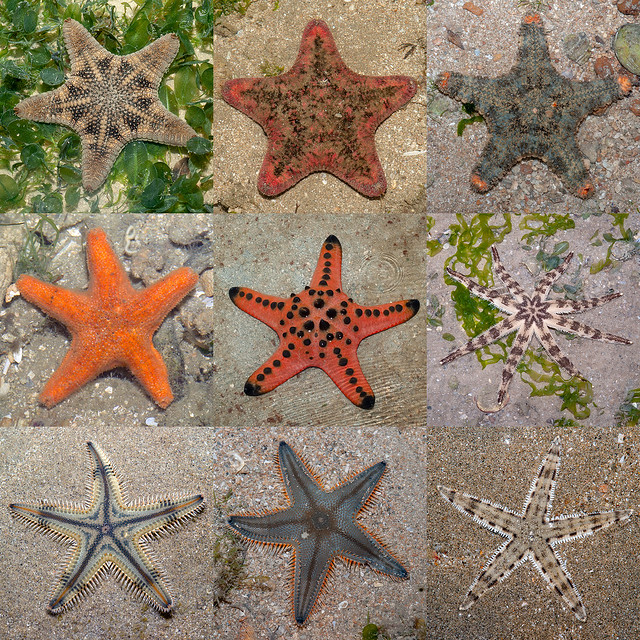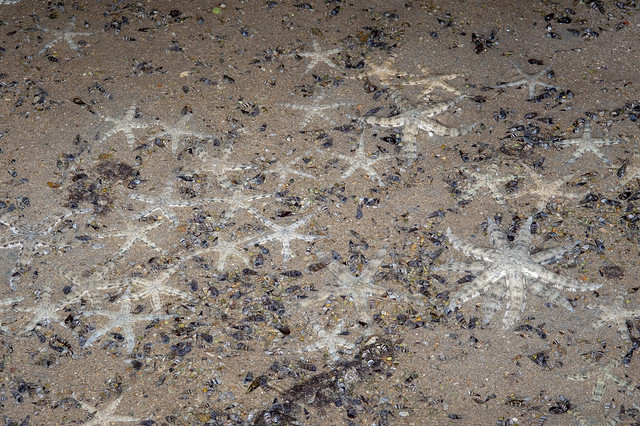 |
| Clockwise from left: Biscuit sea star, Cake sea star, Spiny sea star, Eight-armed sea star, Common sea star, Plain sand star, Painted sand star, Crown sea star with Knobbly sea star in the middle. |
Although often called starfish, these creatures are not fish at all! So it is more correct to call them sea stars. Some sea stars are small and well hidden. Others are large and colourful.
 |
| Knobbly sea stars can grow to be as big as your face! In some meadows, there are baby Knobblies! |
Some sea stars seem to be all arms with long narrow arms and a small central disk.
 |
| The Eight-armed sea star is a fierce and fast moving predator. |
Others have arms that are so short they look like pentagons.
 |
| The Cake sea star has short arms! |
Some sea stars only come out at night. Spending the day buried in the sand.
 |
| The Plain sand star is often abundant but only comes out at night. |
The underside of a sea star is where all the action is. Its mouth is here, facing the ground. Under each arm are grooves with rows of tube feet which it uses to move around.
Aren't sea stars bad for reefs? Don't they eat up all the hard corals?
No, this is a myth. The Crown-of-Thorns sea star is notorious for eating hard corals. This sea star has not been encountered on Singapore shores. In any case, these sea stars are only a danger to reefs when there is a population explosion of them. Such a situation is generally is believed to be due to an imbalance in the natural system. For example, when their predators are overharvested. When there are low numbers of this sea star, they do not cause massive damage.
 |
| NOT seen in Singapore - Crown of Thorns sea star eating corals. Photo by Rore bzh from wikipedia. |
 |
| The harmless Common sea star can be found in large numbers on many of our shores. |
Be kind to our sea stars
Dead or Alive?
All the sea stars that you see are probably alive. You are unlikely to come across a skeleton of a sea star. Dead sea stars disintegrate quickly and do not leave behind whole skeletons. A live sea star also has moving tube feet. When removed from the water, however, sea stars will retract their tube feet and may appear dead. The sea stars you see being sold as tourist souvenirs and cheap ornaments are harvested alive and purposely dried. This is cruel indeed!
 |
| Photo by Jacob Maentz from his story about mass harvest of sea stars for the tourist trade. |
Don't pick up sea stars!
Many sea stars can purposely drop off an arm if it feels threatened. This is how they might escape the jaws of a predator, or if a stone should accidentally trap an arm. If you pick up a sea star by the arm, you may trigger off the same reaction. Also, it is stressful for a sea star to be out of water for a long time. So please admire the sea stars where they are.
 |
| Keep sea stars in water, admire them where they are. |
Don't mutilate sea stars!
Although sea stars are famous for their ability to regenerate lost arm, don't purposely mutilate them. It takes time and resources to regenerate arms. Some take up to a year to replace a lost limb. In the meantime, the sea star is probably disadvantaged. If the central disk is damaged, the sea star may die. You won't get two sea stars when an arm of a sea star is separated.
Should I put a sea star that is high and dry on the sand back into the water?
Sea stars you come across at low tide are used to being out of water during low tide. It is best to leave sea stars were they are.
 |
| Admiring a sea star on the high shore at low tide. Just leave them where they are. |
Where can I see stars in Singapore?
One of the best ways is to ioin intertidal walks by NParks at Chek Jawa, Pulau Ubin or the Sisters Islands Marine Park.
Here's more about Singapore's seagrass meadows and how you can visit them and make a difference for them.
Share your sea star stories! I'd love to hear about them.
Learn more about Singapore sea stars on the wild fact sheets on wildsingapore.
This article is written for Celebrating Singapore Shores as part of International Year of the Reef 2018.


